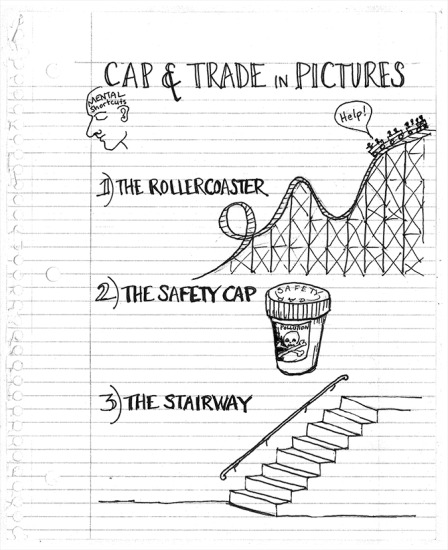We all rely on mental shortcuts to make sense of new information. Often, metaphor and analogy—or pictures—help us get a handle on abstract ideas.
Right now, far-reaching climate and energy policy is back in the news, this time at the state level on the west coast where California has an established cap and trade system, Oregon and Washington are thinking seriously about putting a limit on climate pollution, and British Columbia has a successful carbon tax shift in place.
The time is right to deploy the most compelling illustrations of how smart climate and energy policy works for people and our economy. Here are three mental shortcuts for talking about cap and trade:
1. The roller-coaster. This is not the fun kind of roller-coaster, far from it. It’s the unpredictable and scary oil and coal ride we’re trapped on as long as pollution has no price-tag. It’s time to unhitch local businesses and our families from this risky ride, and invest in a more prosperous and stable clean-energy economy for our communities.
2. A safety cap. A safety cap keeps a lid on pollution—and keeps it locked. The cap is a firm commitment to cutting pollution and an effective way to achieve climate and energy security. No policy measure can substitute for putting a cap on the amount of pollution that we allow into our air.
3. A stairway to energy stability. We stand atop the oil and coal pollution “staircase.” We want to get to the bottom where we’ll enjoy a more stable, safer, clean-energy economy. It would be dangerous to jump to the bottom or run down too fast. Cap and trade steps our economy down to stability, stair by stair, at a manageable pace. It offers flexibility, clear and feasible goals, and a predictable timeline for getting where we want to go.

Click to enlarge. Original Sightline Institute graphic, available under our free use policy.








bryan
Only one comment – these drawing should be reversed, initially it looks like they go left to right, the way we read, implying everything goes up; whereas the article tells us everything should go down…
Anna
Good idea to reverse the stairway–I didn’t think of it that way but you’re right! But the roller coaster is definitely going up as prices for dirty fuels continue to increase (along with dips, rolls, spikes, and drops along the way). Thank you.